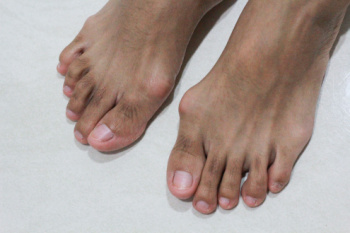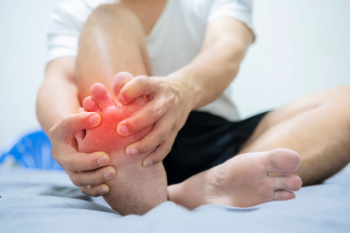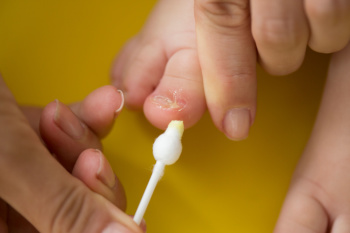Connect With Us
Blog
Items filtered by date: October 2025
When Bunions Become More Than a Bump

Bunions are a common foot deformity that appears as a bony bump at the base of the big toe. They often develop due to genetics, flat feet, arthritis, or prolonged wearing of tight or narrow shoes. Symptoms include swelling, stiffness, and pain that worsens with walking or shoe pressure. As the big toe begins to lean toward the second toe, the base of the toe pushes outward causing a deformity. In mild cases, a podiatrist can help with conservative treatments, such as padding, custom orthotics, footwear modifications, and anti-inflammatory medications. However, when pain becomes constant, mobility is limited, or if the bunion interferes with daily activities, surgery may be necessary to realign the bones and relieve discomfort. A podiatrist will evaluate the severity of the bunion through a physical exam and X-rays and determine whether surgery is needed. It is suggested that you schedule an appointment with a podiatrist if a bunion is causing ongoing pain or difficulty with wearing footwear.
If you are suffering from bunion pain, contact Keleigh Muxlow, DPM of Colorado. Our doctor can provide the care you need to keep you pain-free and on your feet.
What Is a Bunion?
Bunions are painful bony bumps that usually develop on the inside of the foot at the joint of the big toe. As the deformity increases over time, it may become painful to walk and wear shoes. Women are more likely to exacerbate existing bunions since they often wear tight, narrow shoes that shift their toes together. Bunion pain can be relieved by wearing wider shoes with enough room for the toes.
Causes
- Genetics – some people inherit feet that are more prone to bunion development
- Inflammatory Conditions - rheumatoid arthritis and polio may cause bunion development
Symptoms
- Redness and inflammation
- Pain and tenderness
- Callus or corns on the bump
- Restricted motion in the big toe
In order to diagnose your bunion, your podiatrist may ask about your medical history, symptoms, and general health. Your doctor might also order an x-ray to take a closer look at your feet. Nonsurgical treatment options include orthotics, padding, icing, changes in footwear, and medication. If nonsurgical treatments don’t alleviate your bunion pain, surgery may be necessary.
If you have any questions, please feel free to contact our office located in Littleton, CO . We offer the newest diagnostic and treatment technologies for all your foot care needs.
Understanding Pain in the Smaller Toes

Pain in the front of the foot, particularly around the smaller toes, can develop from irritation, overuse, or structural changes in the joints and soft tissues. Wearing tight shoes, high heels, or repetitive stress can inflame the tendons, ligaments, or nerves that support the toes, leading to discomfort or swelling. Sometimes the issue involves joint misalignment or a buildup of pressure beneath the ball of the foot. Advanced imaging such as an MRI scan can help identify hidden causes like soft tissue injury or early joint damage that may not appear on X-rays. Treatment focuses on relieving pressure, improving foot mechanics, and reducing inflammation through custom orthotics, footwear modification, and targeted exercises. If you experience ongoing pain in the lesser toes, it is suggested that you see a podiatrist who can pinpoint the cause and recommend effective options for restoring comfort and balance.
Toe pain can disrupt your daily activities. If you have any concerns, contact Keleigh Muxlow, DPM of Colorado. Our doctor can provide the care you need to keep you pain-free and on your feet.
What Causes Toe Pain?
Most severe toe pain is caused due to a sports injury, trauma from dropping something heavy on the toe, or bumping into something rigid. Other problems can develop over time for various reasons.
Toe pain can be caused by one or more ailments. The most common include:
- Trauma
- Sports injury
- Wearing shoes that are too tight
- Arthritis
- Gout
- Corns and calluses
- Hammertoe
- Bunions
- Blisters
- Ingrown toenails
- Sprains
- Fractures (broken bones)
- Dislocations
When to See a Podiatrist
- Severe pain
- Persistent pain that lasts more than a week
- Signs of infection
- Continued swelling
- Pain that prevents walking
Diagnosis
In many cases the cause of toe pain is obvious, but in others, a podiatrist may want to use more advanced methods to determine the problem. These can range from simple visual inspections and sensation tests to X-rays and MRI scans. Prior medical history, family medical history, and any recent physical traumatic events will all be taken into consideration for a proper diagnosis.
Treatment
Treatments for toe pain and injuries vary and may include shoe inserts, padding, taping, medicines, injections, and in some cases, surgery. If you believe that you have broken a toe, please see a podiatrist as soon as possible.
If you have any questions please contact our office located in Littleton, CO . We offer the newest diagnostic and treatment technologies for all your foot and ankle needs.
Plantar Warts Can Be Treated!
Understanding Hammertoe

Hammertoe is a condition where one or more toes bend abnormally at the middle joint, creating a curled or claw-like appearance. This often happens when muscles and tendons in the toe become imbalanced, pulling the joint into the wrong position. Wearing tight or ill-fitting shoes, high heels, or inherited foot structure can all play a role in its development. At first, hammertoe may cause only mild discomfort, but over time, it can lead to pain, corns, calluses, or difficulty wearing certain shoes. The affected toe may also become stiff, making it harder to move. Treatment depends on how advanced the condition is. Early care can include wearing shoes with a wide toe box, using pads or orthotics, and doing simple stretching exercises. In more severe cases, surgery may be needed to straighten the toe. If you are experiencing pain or changes in your toes, it is suggested that you see a podiatrist for expert advice and guidance.
Hammertoe
Hammertoes can be a painful condition to live with. For more information, contact Keleigh Muxlow, DPM from Colorado. Our doctor will answer any of your foot- and ankle-related questions.
Hammertoe is a foot deformity that affects the joints of the second, third, fourth, or fifth toes of your feet. It is a painful foot condition in which these toes curl and arch up, which can often lead to pain when wearing footwear.
Symptoms
- Pain in the affected toes
- Development of corns or calluses due to friction
- Inflammation
- Redness
- Contracture of the toes
Causes
Genetics – People who are genetically predisposed to hammertoe are often more susceptible
Arthritis – Because arthritis affects the joints in your toes, further deformities stemming from arthritis can occur
Trauma – Direct trauma to the toes could potentially lead to hammertoe
Ill-fitting shoes – Undue pressure on the front of the toes from ill-fitting shoes can potentially lead to the development of hammertoe
Treatment
Orthotics – Custom made inserts can be used to help relieve pressure placed on the toes and therefore relieve some of the pain associated with it
Medications – Oral medications such as anti-inflammatories or NSAIDs could be used to treat the pain and inflammation hammertoes causes. Injections of corticosteroids are also sometimes used
Surgery – In more severe cases where the hammertoes have become more rigid, foot surgery is a potential option
If you have any questions, please feel free to contact our office located in Littleton, CO . We offer the newest diagnostic and treatment technologies for all your foot care needs.
When a Baby Has an Ingrown Toenail

Babies can develop ingrown toenails when the corner of the nail grows into the surrounding skin, often affecting the big toe. Because infant nails are soft and flexible, they may sometimes appear ingrown when they are only curving at the edges. Signs of a true ingrown toenail include redness, swelling, tenderness, and, in some cases, drainage of fluid near the nail. Causes of ingrown toenails include nails being trimmed too short, rounded edges that grow into the skin, or pressure from tight shoes once the baby begins walking. If ignored, an ingrown toenail may lead to infection, making the toe more painful and swollen. A podiatrist can determine if the nail is truly ingrown and provide treatment to ease discomfort, prevent infection, and guide parents on proper nail care as their child grows. If your child develops an ingrown toenail, it is suggested that you promptly schedule an appointment with a podiatrist for an exam and treatment solutions.
Ingrown toenails can become painful if they are not treated properly. For more information about ingrown toenails, contact Keleigh Muxlow, DPM of Colorado. Our doctor can provide the care you need to keep you pain-free and on your feet.
Ingrown Toenails
Ingrown toenails occur when a toenail grows sideways into the bed of the nail, causing pain, swelling, and possibly infection.
Causes
- Bacterial infections
- Improper nail cutting such as cutting it too short or not straight across
- Trauma to the toe, such as stubbing, which causes the nail to grow back irregularly
- Ill-fitting shoes that bunch the toes too close together
- Genetic predisposition
Prevention
Because ingrown toenails are not something found outside of shoe-wearing cultures, going barefoot as often as possible will decrease the likeliness of developing ingrown toenails. Wearing proper fitting shoes and using proper cutting techniques will also help decrease your risk of developing ingrown toenails.
Treatment
Ingrown toenails are a very treatable foot condition. In minor cases, soaking the affected area in salt or antibacterial soaps will not only help with the ingrown nail itself, but also help prevent any infections from occurring. In more severe cases, surgery is an option. In either case, speaking to your podiatrist about this condition will help you get a better understanding of specific treatment options that are right for you.
If you have any questions, please feel free to contact our office located in Littleton, CO . We offer the newest diagnostic and treatment technologies for all your foot care needs.

